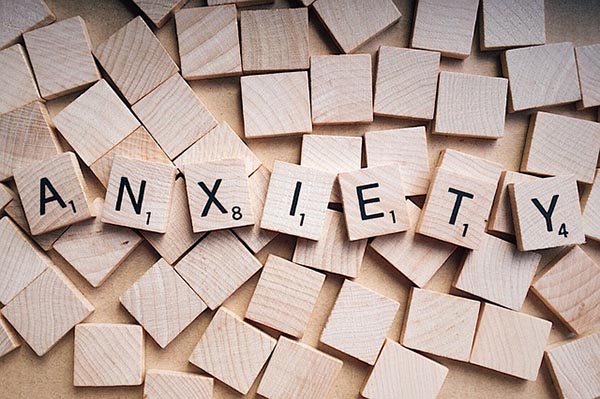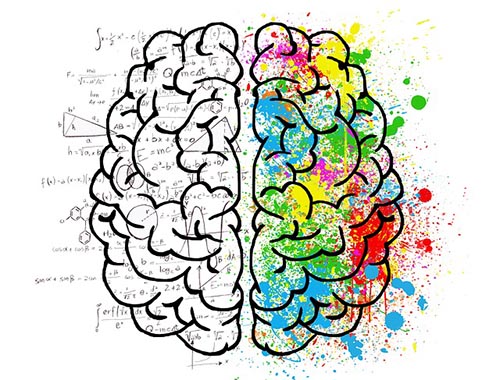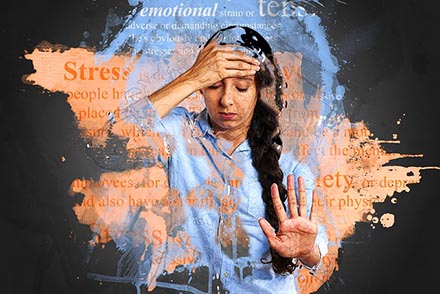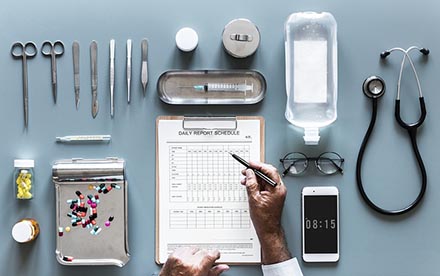Anxiety is a common mental health issue for all developed countries around the world. As the workplace and schools put increasing amount of stress on both adults and children in the society, how detrimental is this growing anxiety issue to the mental and physical health of each individual, and how does it affect the society as a whole? Here are 50 alarming statistics on anxiety disorders that will make you rethink about your anxiety level and your mental wellness.
Prevalence of Anxiety Disorders
- Anxiety disorders have globally increased by almost 50% from 416 billion to 615 million between 1990 to 2013. That means about 10% of the global population is affected by this mental health problem. (WHO)
- The United States have the highest number of anxiety disorder cases in the world as 26.4% of current population suffer from various forms of anxiety disorders. (NBC News)
- Anxiety disorders affect 40 million individuals age 18 and older in the United States. (Anxiety and Depression Association of America)
- It is estimated that 31.1% of Americans will suffer from a form of anxiety disorder at some point in their lives. (National Institute of Mental Health)
- Females in the United States tend be 2 to 3 times more likely to suffer from anxiety disorder (23.4%) than males (14.3%). (National Institute of Mental Health)
- Adults in the age group 30-44 tend to have the highest tendency (22.7%) to suffer from anxiety disorders. The age group 18-29 are also seen to have a high tendency (22.3%) of anxiety disorders (National Institute of Mental Health)
- It is estimated that 31.9% of adolescents suffer from a form of anxiety disorder. 8.3% of these individuals suffer from severe impairment. (National Institute of Mental Health)
- Female adolescents (38.0%) are more likely than male adolescents (26.1%) to suffer from anxiety disorder. (National Institute of Mental Health)
- Genetic factors can make a person 30 to 40% more susceptible to anxiety disorders. (Everyday Health)
- Those who develop symptoms before age of 20 are much more likely to have close relatives who suffer from anxiety disorders as well. Clinical twins genetics studies have found that males have an extremely high heredity factor (close to 100%) in generalized anxiety disorder than females (58%). (Dialogues Clin Neuroscience “Genetics of Generalized Anxiety Disorder and Related Traits”)
I recommend reading the following article:
How Anxiety Affect General Health
- Individuals with anxiety disorder are 3-5 times more likely to visit the doctor. They are 6 times more likely to be hospitalized for psychiatric disorders than people who do not have any anxiety disorders. (Anxiety and Depression Association of America)
- It was found that out of all anxiety disorder sufferers in the United States, 43.5% suffer from mild impairment, 33.7% suffer from moderate impairment and 22.8% suffer from serious impairment. (National Institute of Mental Health)
- Studies have shown that people who have suffered from anxiety disorders are 20% more likely to have earlier deaths than the general population. (The Telegraph)
- Individuals who suffer from anxiety disorders are much more likely to suffer from gastroenteritis and other digestive disorders. It has been discovered that anxiety disorders occur in about 66% of individuals who suffer from irritable bowel syndrome. (Mentalhealth.gov)
- Correlation studies demonstrate that 49% of patients who suffer from chronic respiratory disorders also suffer from anxiety disorders. About 41.3% of these individuals also suffer from muscle spasms and sleep apnea. (Iran J Psychiatry “Severity of Anxiety Disorders in Patients with Chronic Obstructive Pulmonary Disease”)
- Clinical studies have found that as much as 50% of patients suffering from Hashimoto’s Disease also suffer from anxiety disorders. In addition, 40% of these individuals also suffer from various degrees of depression. (PsychCentral)
- Medical studies have found that 14% of diabetes patients suffer from general anxiety disorder while 40% of patients suffer from various degree of anxieties about their health problems. (Mentalhealth.gov)
- Longitudinal medical studies have found the general population to have a 4% risk of developing hypertension, whereas those with anxiety disorders have 14% chance of developing hypertension. This finding suggests that anxiety disorders significantly increases the chance for an individual to develop high blood pressure and possible cardiovascular health issues. (Life Science Medical News)
- Centers for Disease Control and Prevention find that individuals with anxiety disorders are 30% more frequent to suffer from obesity than the general population. (CDC)
- Clinical researches have found that about ⅔ of eating disorder patients also have some form of anxiety disorders. Amongst all types of anxiety disorders, 41% suffer from general anxiety disorder with obsessive compulsive disorder. (Eating Disorder Foundation)
Relationship between Anxiety Disorders and Depression Disorders
- Clinical studies have found that high scores of neuroticism is linked with anxiety disorders and depression disorders. Furthermore, it has been found that those score high in neuroticism are 20 to 45% more likely to suffer from both depression and anxiety disorders. (Am Psychology “Public Health Significance of Neuroticism”)
- Clinical surveys have found that those who suffer from severe form of anxiety disorders and depression were 48% more likely to suffer from heart attack and early deaths. (LiveScience)
- Psychology surveys on self-efficacy in teenagers has a 43% accuracy on predicting anxiety and depression disorders. Those children and teenagers who score low in self-efficacy are much more likely to exhibit symptoms of anxiety and depression disorders. (Personality and Individual Differences “Relationship between Self-Efficacy and Symptoms of Anxiety Disorders and Depression in a Normal Adolescent Sample”)
Treatability of Anxiety Disorders
- In the early 2000s, U.S. healthcare uses $42 billion annually to treat anxiety disorders. That amount takes almost ⅓ of the total mental health patient care expense ($148 billion) in the United States. (Journal of Clinical Psychiatry “Economic Burden of Anxiety Disorders”)
- As of 2016, due to increased medication costs, the treatment of anxiety disorders has escalated to $147 billion.
- It has been estimated that half of the anxiety disorder treatment expenses come from repeated services to patients to relieve symptoms.
- Currently, anxiety disorders and depression cost the US economy $1 trillion each year. It is estimated that with every dollar invested in treatment for these mental disorders, $4 can be saved in health sector and workplace environments. (World Health Organization)
- Studies have shown that screening and treatment programs at the workplace can create a 5% in employee productivity and participation in the workplace. According to the $147 billion spent on treating anxiety disorders and depression, $310 billion was returned as economic value in the workplace. (The Lancet Psychiatry “Scaling-up Treatment of Depression and Anxiety: a Global Return on Investment Analysis”)
- Although anxiety disorders are treatable, only 43.2% of sufferers receive treatment. (Anxiety and Depression Association of America)
- It has been estimated that more than 30% of the United States population do not know they have anxiety disorders. (Anxietycentre.com)
- According to a ADAA survey in 2007, 36% society anxiety disorder patients reported experiencing symptoms for a duration of 10 years or more before actively seeking for medical help. (Stress and Anxiety Center)
Medical Treatment
- The Institute for Safe Medication Practices found that 1 in 6 Americans have at least 1 prescription for psychiatric medication, and 43% of Americans take mood altering medication on a daily basis, and 68% of individuals over the age of 12 reported taking antidepressants for more than 2 years. (CBS News)
- More than 50% of patients responds well to anti-anxiety medications. About 20 to 40% report moderate improvements to medication. (UNC College of Arts & Sciences)
- Anti-anxiety medications usually take 4 to 6 weeks to start lower anxiety symptoms. (Helpguide.org)
- Cognitive-behavioral therapy (also known as CBT) often shows drastic improvement in patients’ well-being within 12 to 20 sessions of treatment. (UNC College of Arts & Sciences)
- Follow-up studies found that 60% of children and adolescents are able to recover from anxiety disorders after receiving CBT treatments. (Journal of Anxiety Disorders “Long-term Effectiveness of Cognitive Behavioral Therapy for Youth with Anxiety Disorders”)
Generalized Anxiety Disorder (GAD)
- About 3.1% of America adult population (6.8 million) suffer from GAD, but only 43.2% seeks treatment. (Anxiety and Depression Association of America)
- Research studies have found that male individuals who suffer from generalized anxiety disorder exhibit much severe telomere erosion than depression and PTSD male patients. This phenomenon is not observed in female patients. This may explain why male GAD patients are twice as likely to die from cancer. (Dialogues Clinical Neuroscience “Genetics of Generalized Anxiety Disorder and Related Traits”)
- As of 2015, there are 80% of children in American with generalized anxiety disorder, but 60% did not receive treatment. (Children’s Mental Health Report)
Social Anxiety Disorder (SAD)
- It has been estimated that 15 million people in the United States are suffering from social anxiety disorder. (Elements Behavioral Health)
- Of all the Americans who suffer from SAD, 31.3% suffer from mild impairment, 38.8% suffer from moderate impairment, and 29.9% suffer from serious impairment. (NIMH)
- Survey studies have found that 66% of SAD patients also suffer from other mental health conditions. (MentalHealth.gov)
Further reading:
Post Traumatic Stress Disorder (PTSD)
- 70-80% of US population will experience a traumatic event at some point in their lives. It has been concluded that out of all these victims, 20% will develop PTSD.
- Surveys indicate that women are 60% more likely to suffer from PTSD. (National Center for PTSD)
- For people who experience severe cases of traumatic events, about 80% will develop PTSD.
- As of 2016, 31.3 million individuals in the United States have PTSD.
- About 11 to 30% veterans of United States suffer from various degrees of PTSD. Studies have shown that 1 in every veteran returning from Afghanistan and Iraq suffer from various degrees of PTSD. (National Center for PTSD)
- Although women only make up 17% of the US army personnel, at least 71% of them will develop PTSD as a result of sexual assault incidences within the ranks. The number can be significantly higher as women army personnel survey studies have indicated only 23% of military sexual assault incidents were reported. (The Solders Project)
- Studies have shown that children are highly susceptible of PTSD. It has been found that 90% of children experiencing sexual abuse will suffer from PTSD. 77% of children experiencing a school shooting will suffer from PTSD. (KidsHealth)
- PTSD individuals used up $23 billion in treatment costs and hospital visits, making them as the most frequent healthcare service users. (New York Times)
Even though there is the “chicken or egg” dilemma concerning the connection between anxiety disorders and various physical and mental health problems, one thing is clear – anxiety disorders can create a snowball effect in escalating existing health problems as well as making the body and mind more susceptible to other diseases. The most important issue is that anxiety disorders are treatable. Instead of waiting and trying to self-treat symptoms, it is best to seek help before the disorder causes a toll on the overall well-being.







